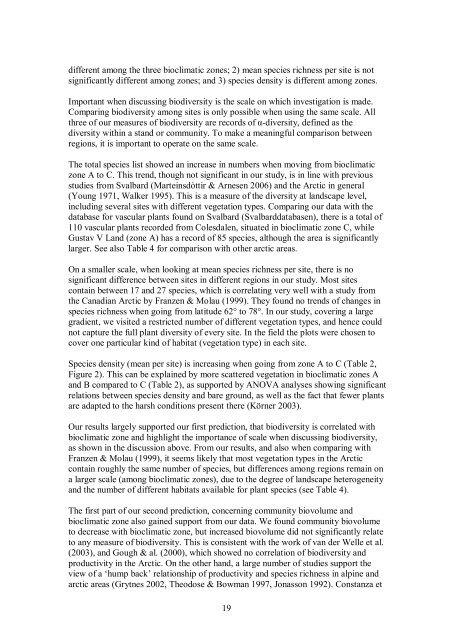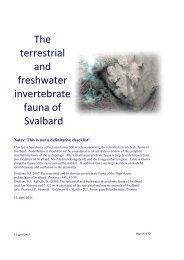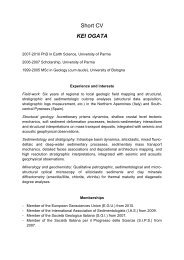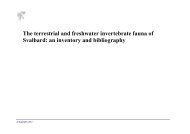Arctic plant ecology: From tundra to polar desert in Svalbard - Unis
Arctic plant ecology: From tundra to polar desert in Svalbard - Unis
Arctic plant ecology: From tundra to polar desert in Svalbard - Unis
Create successful ePaper yourself
Turn your PDF publications into a flip-book with our unique Google optimized e-Paper software.
different among the three bioclimatic zones; 2) mean species richness per site is not<br />
significantly different among zones; and 3) species density is different among zones.<br />
Important when discuss<strong>in</strong>g biodiversity is the scale on which <strong>in</strong>vestigation is made.<br />
Compar<strong>in</strong>g biodiversity among sites is only possible when us<strong>in</strong>g the same scale. All<br />
three of our measures of biodiversity are records of αdiversity, def<strong>in</strong>ed as the<br />
diversity with<strong>in</strong> a stand or community. To make a mean<strong>in</strong>gful comparison between<br />
regions, it is important <strong>to</strong> operate on the same scale.<br />
The <strong>to</strong>tal species list showed an <strong>in</strong>crease <strong>in</strong> numbers when mov<strong>in</strong>g from bioclimatic<br />
zone A <strong>to</strong> C. This trend, though not significant <strong>in</strong> our study, is <strong>in</strong> l<strong>in</strong>e with previous<br />
studies from <strong>Svalbard</strong> (Marte<strong>in</strong>sdòttir & Arnesen 2006) and the <strong>Arctic</strong> <strong>in</strong> general<br />
(Young 1971, Walker 1995). This is a measure of the diversity at landscape level,<br />
<strong>in</strong>clud<strong>in</strong>g several sites with different vegetation types. Compar<strong>in</strong>g our data with the<br />
database for vascular <strong>plant</strong>s found on <strong>Svalbard</strong> (<strong>Svalbard</strong>databasen), there is a <strong>to</strong>tal of<br />
110 vascular <strong>plant</strong>s recorded from Colesdalen, situated <strong>in</strong> bioclimatic zone C, while<br />
Gustav V Land (zone A) has a record of 85 species, although the area is significantly<br />
larger. See also Table 4 for comparison with other arctic areas.<br />
On a smaller scale, when look<strong>in</strong>g at mean species richness per site, there is no<br />
significant difference between sites <strong>in</strong> different regions <strong>in</strong> our study. Most sites<br />
conta<strong>in</strong> between 17 and 27 species, which is correlat<strong>in</strong>g very well with a study from<br />
the Canadian <strong>Arctic</strong> by Franzen & Molau (1999). They found no trends of changes <strong>in</strong><br />
species richness when go<strong>in</strong>g from latitude 62° <strong>to</strong> 78°. In our study, cover<strong>in</strong>g a large<br />
gradient, we visited a restricted number of different vegetation types, and hence could<br />
not capture the full <strong>plant</strong> diversity of every site. In the field the plots were chosen <strong>to</strong><br />
cover one particular k<strong>in</strong>d of habitat (vegetation type) <strong>in</strong> each site.<br />
Species density (mean per site) is <strong>in</strong>creas<strong>in</strong>g when go<strong>in</strong>g from zone A <strong>to</strong> C (Table 2,<br />
Figure 2). This can be expla<strong>in</strong>ed by more scattered vegetation <strong>in</strong> bioclimatic zones A<br />
and B compared <strong>to</strong> C (Table 2), as supported by ANOVA analyses show<strong>in</strong>g significant<br />
relations between species density and bare ground, as well as the fact that fewer <strong>plant</strong>s<br />
are adapted <strong>to</strong> the harsh conditions present there (Körner 2003).<br />
Our results largely supported our first prediction, that biodiversity is correlated with<br />
bioclimatic zone and highlight the importance of scale when discuss<strong>in</strong>g biodiversity,<br />
as shown <strong>in</strong> the discussion above. <strong>From</strong> our results, and also when compar<strong>in</strong>g with<br />
Franzen & Molau (1999), it seems likely that most vegetation types <strong>in</strong> the <strong>Arctic</strong><br />
conta<strong>in</strong> roughly the same number of species, but differences among regions rema<strong>in</strong> on<br />
a larger scale (among bioclimatic zones), due <strong>to</strong> the degree of landscape heterogeneity<br />
and the number of different habitats available for <strong>plant</strong> species (see Table 4).<br />
The first part of our second prediction, concern<strong>in</strong>g community biovolume and<br />
bioclimatic zone also ga<strong>in</strong>ed support from our data. We found community biovolume<br />
<strong>to</strong> decrease with bioclimatic zone, but <strong>in</strong>creased biovolume did not significantly relate<br />
<strong>to</strong> any measure of biodiversity. This is consistent with the work of van der Welle et al.<br />
(2003), and Gough & al. (2000), which showed no correlation of biodiversity and<br />
productivity <strong>in</strong> the <strong>Arctic</strong>. On the other hand, a large number of studies support the<br />
view of a ‘hump back’ relationship of productivity and species richness <strong>in</strong> alp<strong>in</strong>e and<br />
arctic areas (Grytnes 2002, Theodose & Bowman 1997, Jonasson 1992). Constanza et<br />
19








